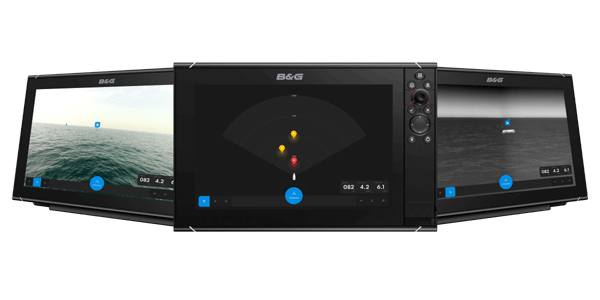SEA.AI Employs Machine Vision and AI Improving Maritime Safety and Security

The use of traditional electronic aids has dramatically reduced the number of collisions at sea over the last decades, especially at night and in poor visibility. Radar and AIS integrated into ECDIS in particular have improved the safety of all seafarers, but these devices have their limitations. Harnessing the power of the latest in AI and “machine vision” technology, SEA.AI addresses some of the shortcomings of existing systems. Its Austrian-designed and manufactured solutions are now available for commercial, defense, fishing, workboat, and rescue vessels as well as the leisure cruising and racing markets.
Since its rapid introduction during and post-World War II, radar technology has become more refined and precise and has introduced valuable features like ARPA, but even top-of-the-range equipment still struggles to display targets with a weak radar signature, especially at long and short ranges. Meanwhile, over the last two decades, AIS has revolutionized the tracking and identification of vessels globally both mid-ocean and close to land either via VHF or satellite transponders. AIS comes into its own when each vessel’s ID, position, course, and speed is superimposed over an electronic chart or ECDIS which in turn displays land, depth contours, fixed navigation marks, obstructions, etc.
Using its state-of-the-art technology SEA.AI excels at identifying potential collision threats, day or night, at short-medium range. Mimicking someone on watch - albeit in a vastly augmented way - SEA.AI maintains a 360° watch around a vessel via daylight and infrared cameras. Its two high-resolution daylight cameras are capable of operating in the lowest light and contrast situations, while its two thermal cameras have a sensitivity of 0.05°C to provide ‘vision’ at night. The cameras are gyro and digitally stabilized and are housed inside a robust waterproof unit typically mounted at the highest point of a vessel.
These cameras integrate with SEA.AI’s machine vision and AI technology to detect and then identify targets. This is done first by recording multiple visual and thermal images of a target. From these, it identifies targets and eliminates any interference due to the sea state, regardless of its severity, or poor visibility. It then, in real-time, compares these images with those that reside in its giant proprietary database of marine objects. At present this database contains more than 10 million thermal and daytime images of potential targets, enabling SEA.AI to provide the most comprehensive digital interpretation of a vessel’s surroundings. The database continually expands and improves through advanced deep-learning techniques. Any new set of data or extra ‘knowledge’ is regularly incorporated and delivered to SEA.AI users via software updates.
In making this comparison SEA.AI determines whether or not a target it examines represents a potential threat. Threats that SEA.AI can identify and other technology might not include craft such as small fishing boats or pleasure craft without AIS and larger flotsam such as semi-submerged containers. SEA.AI’s alarms will then of course alert the watch to any potential collision hazards and also has functionality allowing such targets to be tracked. The system is stand-alone and requires no internet connection and unlike radar, which requires a target to have some sort of radar signature to provide a vital echo, SEA.AI can detect objects regardless of the material they are made of.
Javier Almenara – Fleet Inspector at the ferry company Fred Olsen Express S.A confirms, "We recommend this system because it has a software flexibility that allows goes beyond the limits of other equipment. SEA.AI is the ideal complement [for radar and AIS]."

Container floating in the ocean detected and displayed on the SEA.AI system
The output from SEA.AI is compatible with various displays, including computers, phones, and chart plotters. Additionally, its data can be overlayed on electronic charts alongside radar and AIS information using navigational software such as TimeZero Professional or other compatible interfaces.
With its cameras suitably mounted, SEA.AI’s Sentry model will identify larger vessels not fitted with AIS up to a range of 7.5km; smaller craft such as local fishing boats, dinghies, and inflatables up to 3km, and potentially hazardous objects as small as buoys or a person overboard, up to 700 meters away. This capability, enhanced by its thermal cameras, makes the SEA.AI Sentry an invaluable tool for search and rescue operations.
Théo Turbe, French Coastguard Onboard Crew Member comments: “SEA.AI detects people and boats by itself. At night, you can see as if in daylight and it immediately detects the people in the water. You can't necessarily see them from the bridge, and as it's thermal, it's good, because you can see the person in the water directly. It makes our job easier as it allows us to quickly be able to rescue people that we might not otherwise be able to save without this tool.”
SEA.AI information display
It monitors a vessel’s perimeter up to a selectable range, day or night, via its cameras, whether the ship is at anchor or navigating risky seas. This is useful given that the ICC International Maritime Bureau's recent report indicates an increase in piracy globally, targeting shipping. Over the first nine months of 2023, there were 99 attacks, representing an increase of 10 percent, with an especially alarming rise in incidents of crews being taken hostage.
As the first to bring machine vision and AI to maritime applications, SEA.AI boasts unmatched expertise and superior performance in the field. With a team of over 60 professionals based in France, Austria, Portugal, and the United States, the company is committed to establishing its technology as the new standard for safety in the maritime sector.
This article is sponsored by SEA.AI. For more information please visit the company online.
The opinions expressed herein are the author's and not necessarily those of The Maritime Executive.

